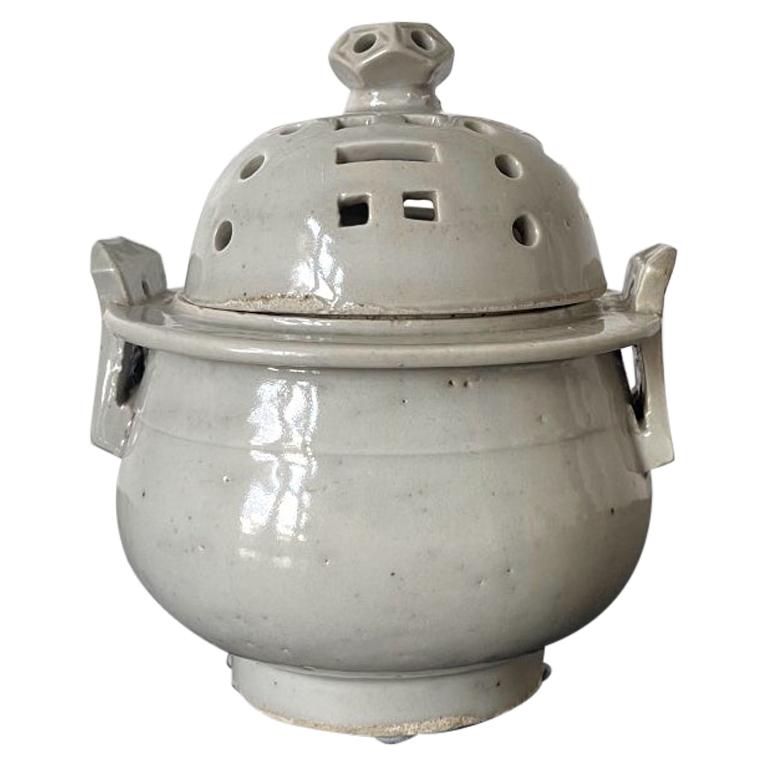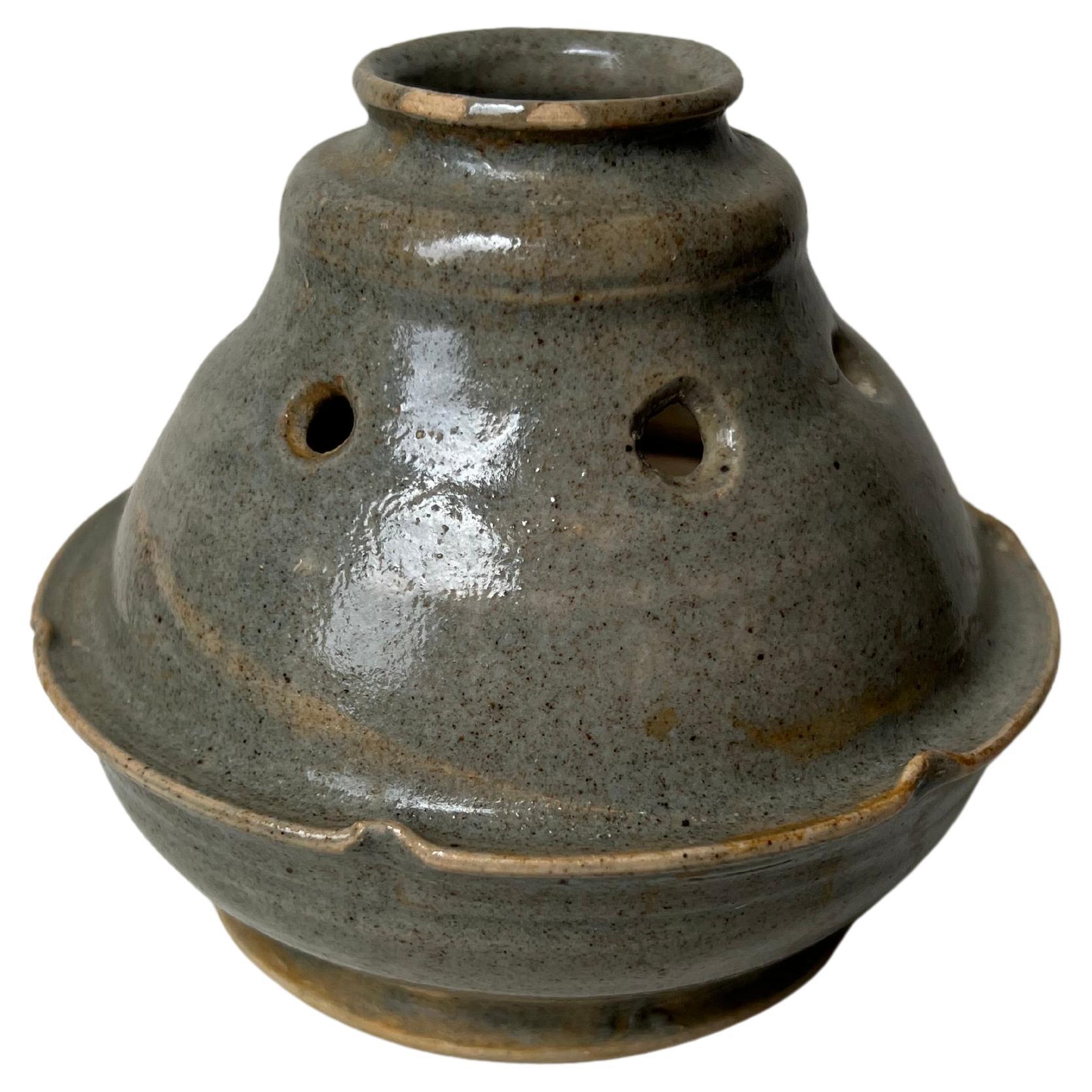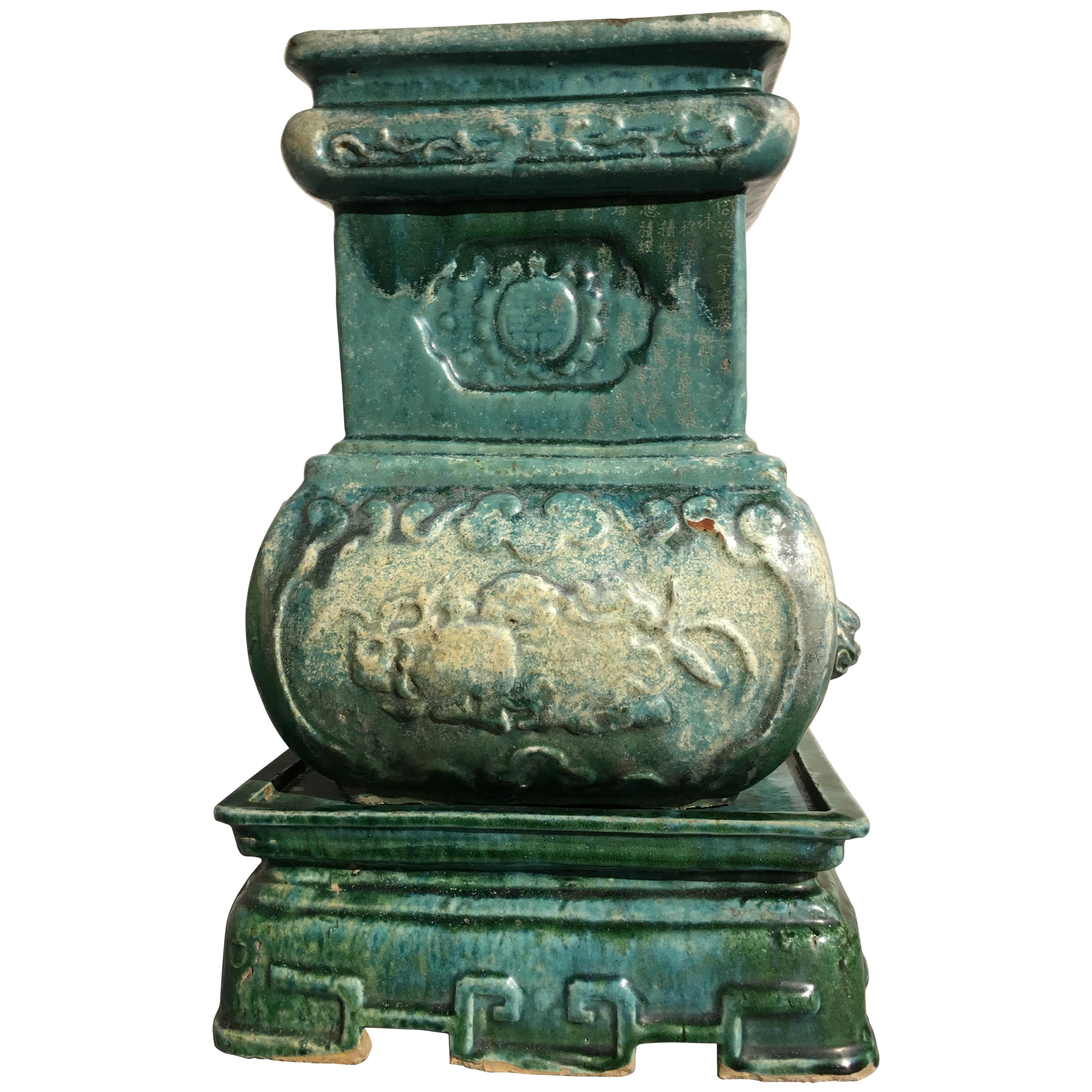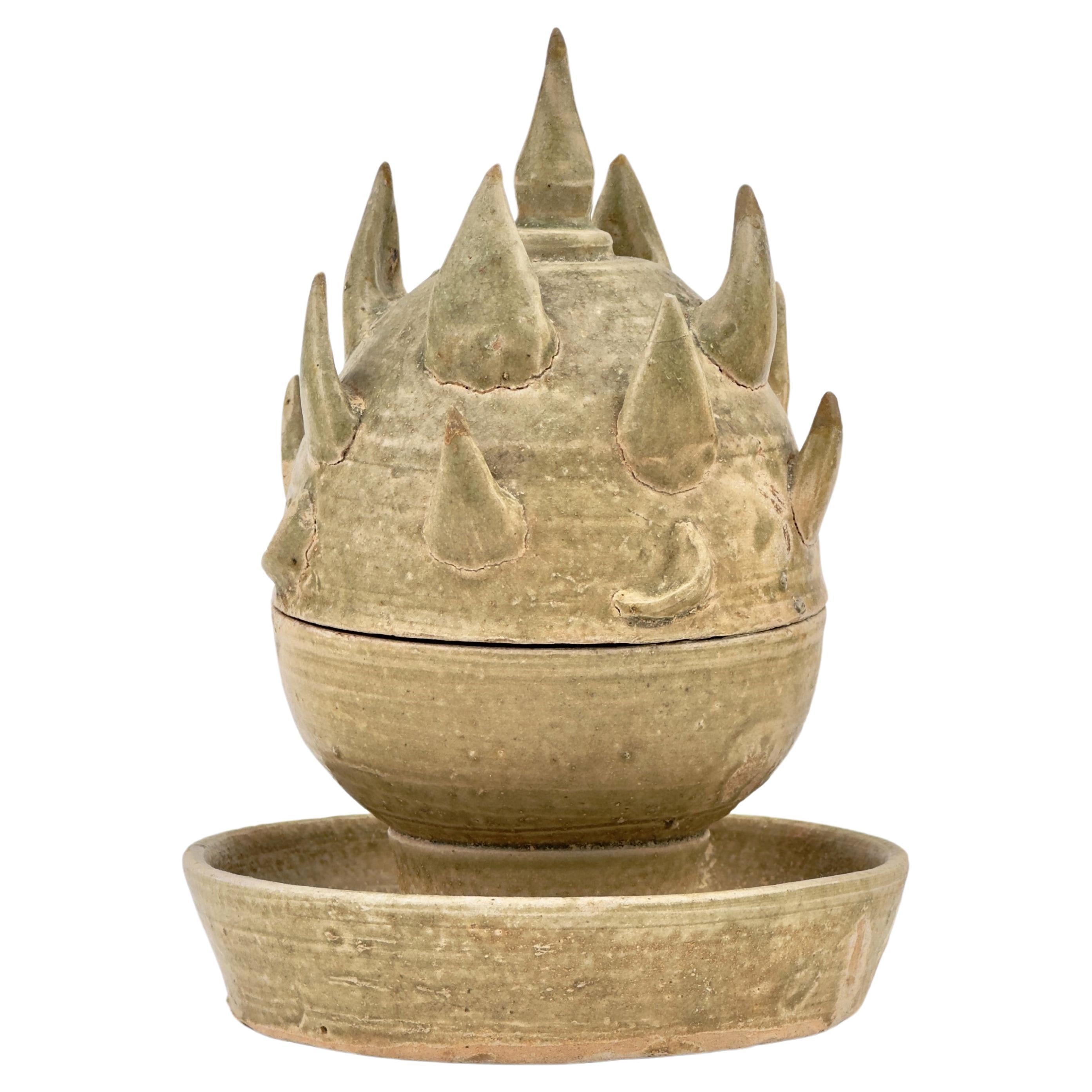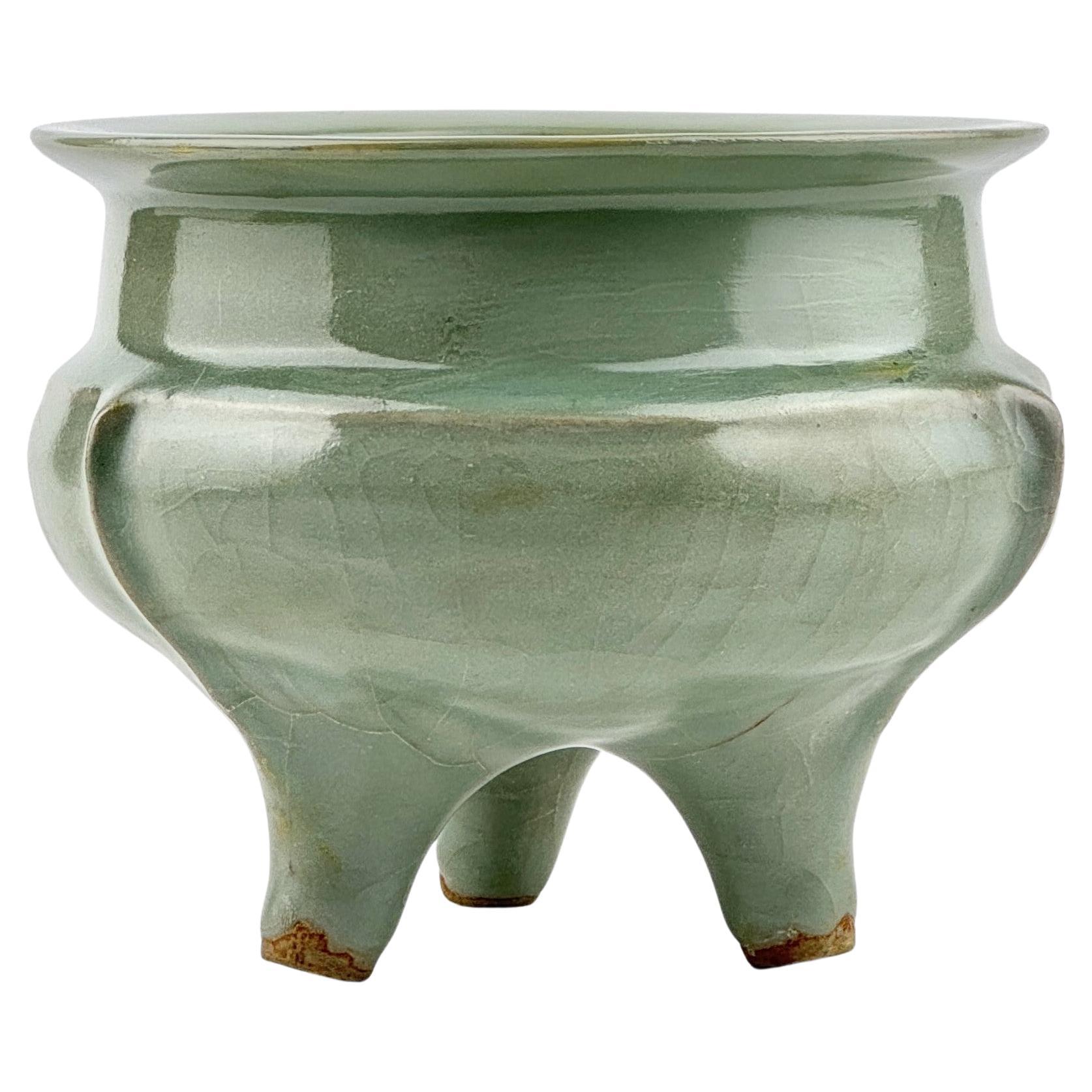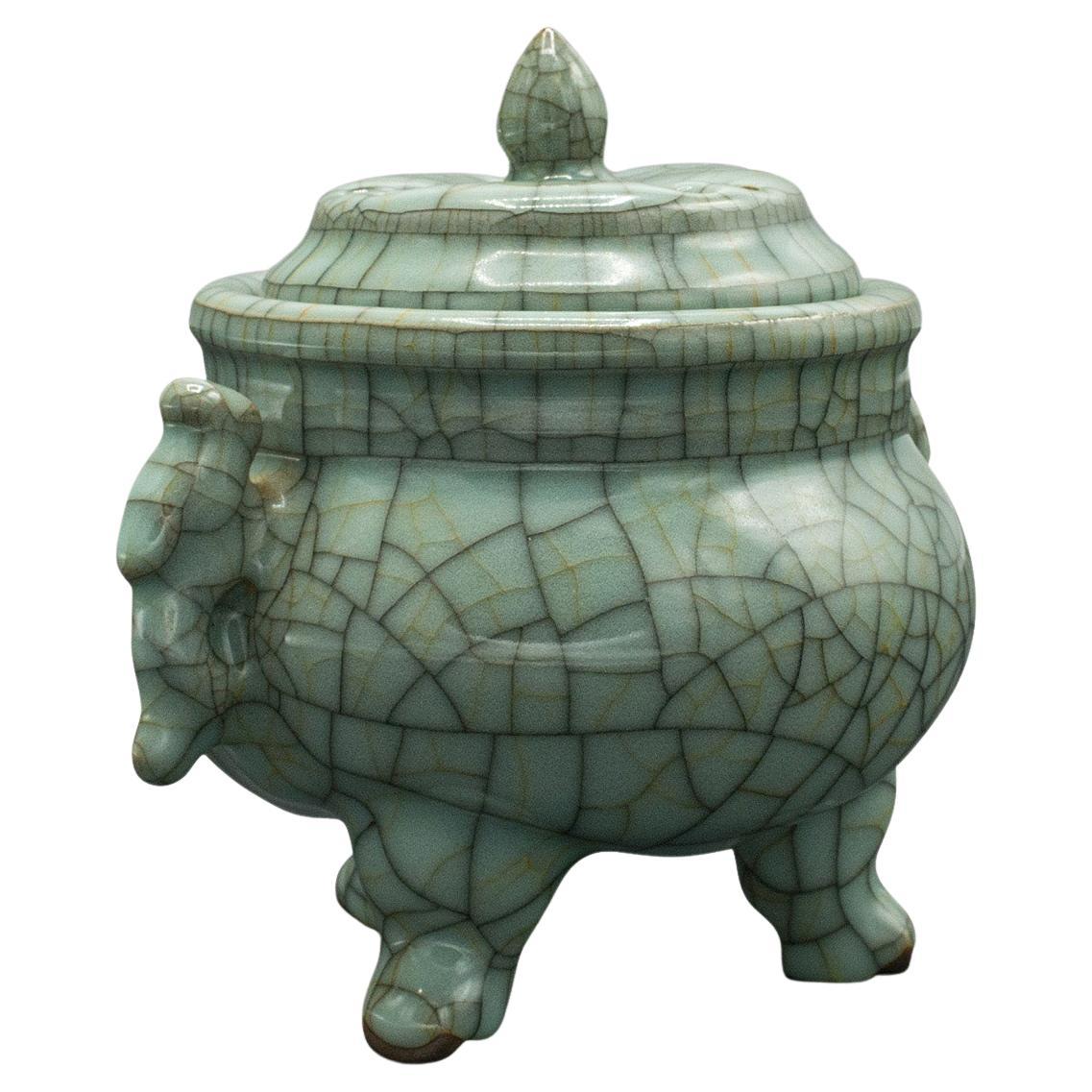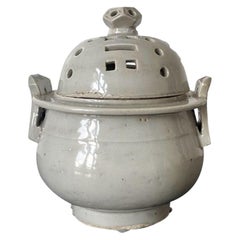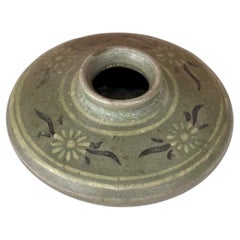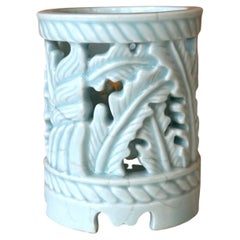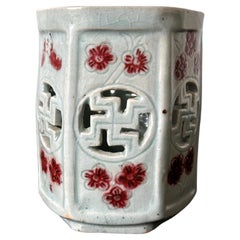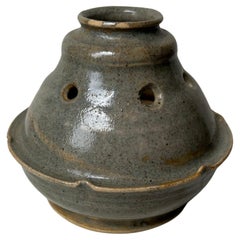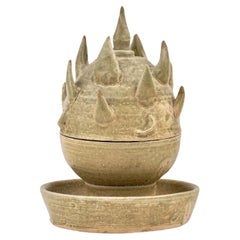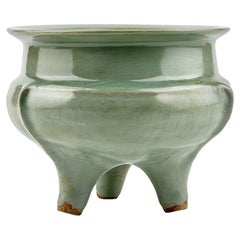Items Similar to Korean Celadon Ritual Incense Burner Joseon Dynasty
Want more images or videos?
Request additional images or videos from the seller
1 of 21
Korean Celadon Ritual Incense Burner Joseon Dynasty
$6,800
£5,231.01
€6,071.72
CA$9,589.62
A$10,741.99
CHF 5,642.08
MX$130,619.16
NOK 71,447.18
SEK 67,822.59
DKK 45,315.59
About the Item
An antique Korean ritual incense burner circa 19th century (late Joseon dynasty). This type of porcelain incense burner was made in Bunwon Kiln in Gwangju, Gyeonggi Do, near Seoul. Used in ceremonial occasions, the vessel was potted in steady and thick walls and the surface was covered in a whitish celadon glaze. It is of an archaic Chinese form with rounded body and two ears, each pierced with three dots. Interestingly, the cover features groups of cutout trigrams in the shapes of four of the eight Bagua (Palgwae in Korean) symbols that represent Water, Matal, fire and thunder respectively. Despite its vernacular appearance, incense burner like this has a strong religious significance and was believed to be used on the altar table in the Buddhist temple for worshiping.
A nearly identical piece from Philadelphia Museum of Art Accession Number 2000-80-12a,b was featured in a touring exhibition "Treasures from Korea Arts and Culture of the Joseon Dynasty 1392-1910" and illustrated in the catalog of the same name on page 219. See photo.
Another one is in the collection of Virginia Museum of Fine Art, 2016.25a-b. (on view). See last two photos taken by us.
Also illustrated on page 312 in "Korean Art from the Gompertz and Other Collections in the Fritzwilliam Museum, Cambridge (shown in the last two photos).
- Dimensions:Height: 6.5 in (16.51 cm)Diameter: 6 in (15.24 cm)
- Style:Archaistic (In the Style Of)
- Materials and Techniques:
- Place of Origin:
- Period:
- Date of Manufacture:19th Century
- Condition:Wear consistent with age and use. General surface patina and wear. Small glaze imperfection around lid, base, and missing glaze spots on the body near the ears. A tight crack line by mouth, two on lower side, one exposing the kaolin underneath, likely kiln-occurrence. Surface only.
- Seller Location:Atlanta, GA
- Reference Number:1stDibs: LU945039784772
About the Seller
4.9
Platinum Seller
Premium sellers with a 4.7+ rating and 24-hour response times
Established in 2006
1stDibs seller since 2010
565 sales on 1stDibs
Typical response time: <1 hour
- ShippingRetrieving quote...Shipping from: Atlanta, GA
- Return Policy
Authenticity Guarantee
In the unlikely event there’s an issue with an item’s authenticity, contact us within 1 year for a full refund. DetailsMoney-Back Guarantee
If your item is not as described, is damaged in transit, or does not arrive, contact us within 7 days for a full refund. Details24-Hour Cancellation
You have a 24-hour grace period in which to reconsider your purchase, with no questions asked.Vetted Professional Sellers
Our world-class sellers must adhere to strict standards for service and quality, maintaining the integrity of our listings.Price-Match Guarantee
If you find that a seller listed the same item for a lower price elsewhere, we’ll match it.Trusted Global Delivery
Our best-in-class carrier network provides specialized shipping options worldwide, including custom delivery.More From This Seller
View AllKorean white Porcelain Ritual Incense Burner with Bagua Pattern Joseon Dynasty
Located in Atlanta, GA
An antique Korean ritual incense burner circa 19th century, late Joseon dynasty. It was made in Bunwon Kiln in Gwangju, Gyeonggi Do, near Seoul. The ceramic container has a thickly b...
Category
Antique 19th Century Korean Archaistic Ceramics
Materials
Ceramic
Small Korean Celadon Oil Jar with Slip Inlay Goryeo Dynasty
Located in Atlanta, GA
A small Korean ceramic celadon oil jar with inlay design from Goryeo Dynasty (918 to 1392AD) circa 12-13th century. This type of mini jars from Goryeo period, were made specifically ...
Category
Antique 15th Century and Earlier Korean Archaistic Ceramics
Materials
Ceramic
Rare Korean Ceramic Brush Holder Joseon Dynasty
Located in Atlanta, GA
A rare Korean porcelain brush holder in Banana Leaves pattern from late Joseon dynasty circa 19th century. Cherished by the scholars, this brush...
Category
Antique 19th Century Korean Other Ceramics
Materials
Ceramic
Korean Reticulated Celadon Brush Holder Joseon Dynasty
Located in Atlanta, GA
A Korean porcelain brush holder in hexagon form from the end of Joseon dynasty circa late 19th century. Cherished by the scholars, brushpot like this would grace the desk in the man'...
Category
Antique Late 19th Century Korean Other Ceramics
Materials
Ceramic
Rare Japanese Porcelain Incense Burner with Inlays Makuzu Kozan
By Makuzu Kozan
Located in Atlanta, GA
A porcelain incense burner (koro) made by Japanese potter Makuzu Kozan (also known as Miyagawa Kozan, 1842-1916) circa 1890s-1900s (end of Meiji Period). The koro features an elegant...
Category
Antique Late 19th Century Japanese Meiji Ceramics
Materials
Ceramic
Faceted Korean Ceramic Celadon Jar Joseon Dynasty
Located in Atlanta, GA
A small ceramic celadon storage jar circa 18th century of Korean Joseon Dynasty. The melon shape jar with a mouth and base of the same size display a beautiful harmony in its form. T...
Category
Antique 18th Century Korean Other Ceramics
Materials
Ceramic
You May Also Like
Vintage Incense Burner / Joss Stick Holder
Located in LOS ANGELES, CA
Small and compact incense / joss stick holder. Unknown age and similar in style to antique Chinese holders. Single, one-piece unit with large opening at top and (6) smaller holes for...
Category
Mid-20th Century Ceramics
Materials
Ceramic
Chinese Qing Dynasty Green Glazed Pottery Incense Burner, Dated 1863
Located in Austin, TX
A gorgeous green glazed large Chinese pottery censer of Archaistic shape called a fanghu, set on a separate stand, Qing dynasty, second year of Tongzhi, 1863.
The censer or incense burner crafted in two parts and covered in a thick, runny and unctuous glaze, ranging from dark green to turquoise green, to pale celadon. The neck with shou (longevity) medallions. The body decorated in relief with fruit, pomegranate and finger citron (Buddha's hand). The sides fitted with lion mask handles. The stand with a key fret design, and a pierced Chinese...
Category
Antique 1860s Chinese Qing Ceramics
Materials
Pottery
Rare Boshan Incense Burner Yue Celadon, Jin dynasty
Located in seoul, KR
The Boshan incense burner is particularly notable among Han dynasty incense burners for its unique shape. Designed to resemble a mountain or even a mythical mountain, it is characterized by its pointed peaks that rise upwards. These peaks often function as vents for the smoke, creating an effect reminiscent of a volcanic eruption.
The body of the incense burner is typically round, with multiple small peaks surrounding a central, larger peak. The material used is mainly ceramic, although there are instances where they were made of bronze. It is presumed that this incense burner was used for religious or ceremonial purposes during its time. The colors of these burners are usually in shades of pale green or greyish brown, with the application of glaze to achieve a variety of colors on occasion.
Such incense burners are often found in tombs or ritual sites, and their purpose was to burn incense for purification of space or to produce pleasant aromas. The Boshan incense burner also represents a significant cultural heritage, showcasing the craftsmanship and artistic values of the period. Today, it is considered a quintessential example of ancient Chinese art.
Period : Han-Jin Dynasty
Type : Incense Burner
Medium : Yue celadon...
Category
Antique 15th Century and Earlier Hong Kong Han Antiquities
Materials
Stoneware
$5,960 Sale Price
60% Off
Rare Longquan Celadon Tripod Incense Burner, Song-Yuan Dynasty
Located in seoul, KR
The vessel features a compressed body supported by three tapered feet and a flat, outwardly flaring rim. Three slender flanges originate from a subtle ridge on the shoulder and exten...
Category
Antique 15th Century and Earlier Hong Kong Antiquities
Materials
Celadon
$17,500 Sale Price
50% Off
Vintage Oriental Censer, Chinese, Celadon, Incense Burner, Art Deco, Circa 1940
Located in Hele, Devon, GB
This is a vintage Oriental censer. A Chinese, celadon incense burner, dating to the late Art Deco period, circa 1940.
Enthusiastically decorated wit...
Category
Mid-20th Century Chinese Decorative Bowls
Materials
Celadon
A Longquan Celadon Five-spouted Jar, Northern Song Dynasty (960~1127)
Located in seoul, KR
The jar features a round body with well-proportioned four distinct tiers and a short, stable foot. The surface is coated in a deep green Longquan celadon glaze, showcasing the sprout...
Category
Antique 15th Century and Earlier Hong Kong Antiquities
Materials
Celadon
$6,175 Sale Price
35% Off
More Ways To Browse
Antique Ritual
Korea Ceramics
Glazed Korean
Virginia 19th Century
Chinese Incense Burner
19th Century Chinese Altar Table
Round Ceramic Wall Art
Buddhist Altar
Antique Asian Altar Table
Chinese Ritual Vessels
Antique Table Mats
Antique Buddhist Altars
Korean Celadon
Korean Temple
Chinese Porcelain Incense
Chinese Incense Table
Antique Korean Celadon
Chinese Temple Table
